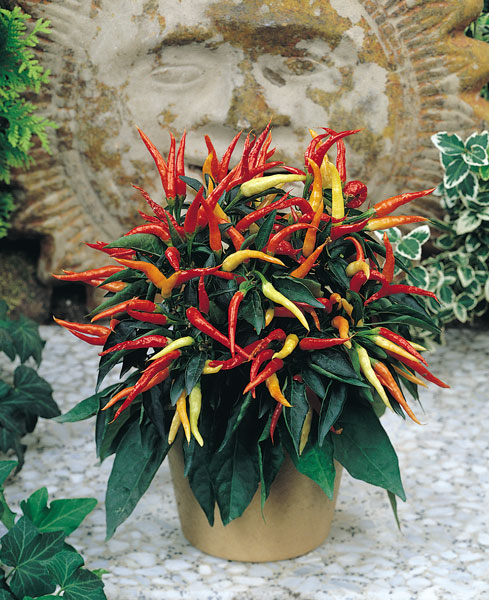5/1/2018
Some Like It Hot
Jeanne Svob

Colorful ornamental peppers are pretty as a picture, with their multicolored fruits and attractive foliage. Ornamental peppers add a bounty of color and interesting textures to containers and landscape beds, yet they’re often underutilized. How can we effectively incorporate them into our bedding and container sales?
Spice up spring programs
Varieties like Black Pearl, Calico, Purple Flash and the new All-America Selections (AAS) winner, Onyx Red can be sold on the merits of their attractive foliage alone. They’ll be saleable in 4.5-in. pots for summer bedding or container transplants in just 14 to 16 weeks from sowing. Plants will flourish in the garden through the summer heat, adding striking fruit colors in June and July.
Black Pearl can be the perfect focal point in a summer container mixed with lavender, rose, pink or even red flowers. Slightly shorter, Calico and Purple Flash make fantastic mid-height border plants in upscale bed designs and as accent plants in color bowls and window boxes.
Onyx Red won an AAS award for its compact, branching habit, deep black foliage and abundance of small red fruits. This new introduction adds striking color in bed borders or to sell in decorative 4- to 6-in. pots to dress up patio tables.
Fiery fall sales
If your spring market is crowded with an abundance of flowering annuals and perennials, it may be difficult for pretty peppers to compete for the attention of spring shoppers. That’s okay because ornamental peppers are awesome in fall programs, too!
Pictured: Medusa Ornamental Pepper.
Ornamental peppers flourish in heat and high light, so they’re an ideal crop to put into production as your spring plants are moving out the door. Total crop time from sowing to mature fruit in summer production is 15 to 20 weeks. Starting with seed in April or plugs in May, you can finish colorful pots of peppers for late August to September sales.
Inspire impulse sales with peppers in decorative pots; they can move from the patio table to the kitchen windowsill before the first frost. Depending upon the chemical regimen used in production, all ornamental peppers are edible, though they’re not considered culinary. Fruits can be very hot!
The colorful fruits are perfectly suited to fall combinations. Combination planters are the ideal way for home garden decorators to transition their summer gardens into a fall color palette. The bright and varied colors of ornamental pepper fruits can pull all the colors of your combos together.
Consider Black Pearl as a focal plant or the more compact Onyx Red as an accent plant in combination with rose or red ornamental kale, blue asters and lavender, rose or light blue pansies. It’s worth noting that Black Pearl is also an AAS award winner, so you can count on it to perform dependably for the end user.
Purple Flash or Calico blend beautifully with white kale, osteospermum and pink or purple mums. Add some white, blue or purple pansies for more color and texture.
The bolder yellow, orange and red fruits of Chilly Chili (another AAS award winner) and Medusa are the perfect accent to orange, yellow and red mums, and pansies. Add small pumpkin or gourd “props” to your containers to create a complete fall display. As an added bonus, both Chilly Chili and Medusa have non-pungent fruit, so they’re safer choices to use around curious small children and pets.
We should mention that ornamental peppers aren’t frost tolerant, but they’ll persist long enough to provide an abundance of color through the warmer days of fall. They fulfill their purpose early and are often overgrown by the mums, asters, kales, grasses and pansies sharing their space before the first frost hits.
Pepper your assortment
While we’ve mentioned only a few by name, there are many more ornamental pepper varieties on the market with characteristics to meet many needs, preferences and color palettes. They range in size from 4 in. x 6 in., up to 14 in. x 16 in. Foliage colors can be variegated, glossy green or deep purple. Fruit colors include orange, yellow, red, purple or all of the above. Your seed or plug supplier can help you identify the right varieties and product forms to fit your program. GT
Jeanne Svob is Seed Business Manager for Griffin. She can be reached at jsvob@griffinmail.com.